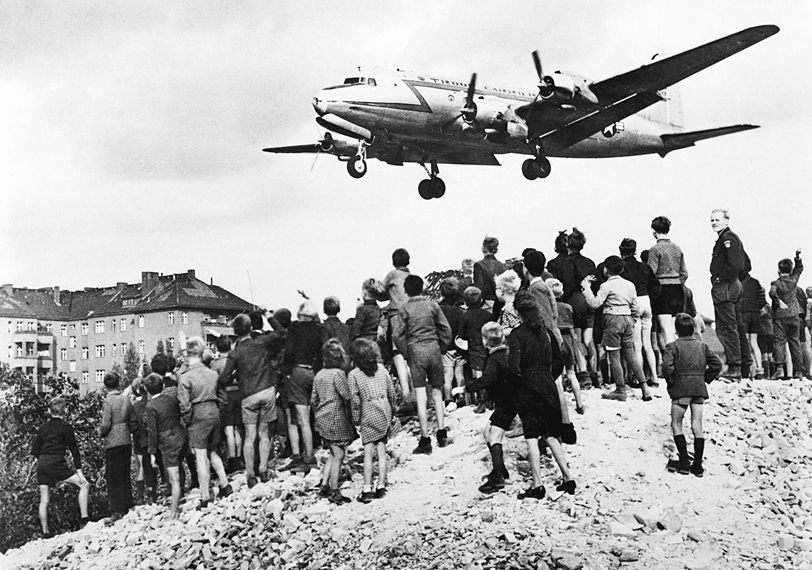A History of World Societies:
Printed Page 957
A History of World Societies Value
Edition: Printed Page 967
The Cold War and the Division of Europe
The Cold War originated in disputes over the political outcome of the war. During talks among the three major powers — the United States, Britain, and the Soviet Union — held toward the end of the war, Soviet leader Joseph Stalin, who had lived through two German invasions, insisted that control of eastern Europe was the best way to guarantee military security from Germany. Where U.S. president Franklin Roosevelt had been inclined to accommodate these demands, his successor, Harry Truman, demanded free elections throughout eastern Europe. Stalin refused. Philip Mosely, a founder of the academic discipline of Soviet studies in the United States, recalled Stalin stating at the 1945 Potsdam Conference that “any freely elected government would be anti-
Truman refused to negotiate with Stalin, bolstered by the fact that the United States was the only country that possessed atomic weapons at the end of the war. Soviet actions deepened the rift with the United States. Just as the U.S. sense of security came from having a monopoly on the atomic bomb, Stalin pursued security for the Soviet Union by militarily occupying eastern Europe and imposing obedient governments. These countries were considered Soviet satellites — nations whose politics and economics were dictated by the Soviet Union. They provided a buffer that shielded the Soviet Union from the threat of western European aggression of the kind the Soviet Union had faced in the Second World War and that Russia had faced in the First World War.
President Truman misread these occupations as a campaign for world domination. Communist movements beyond Stalin’s occupation zone in Greece and China fed these fears. In October 1945 Truman declared that the United States would never recognize governments established by force, establishing the Truman Doctrine, aimed at “containing” communism to areas already occupied by the Soviet army by providing military and economic support to governments threatened by Communist control. (His reference to regimes imposed by force applied only to Europe and countries threatened by communism, not to European colonial domination in Asia and Africa.)
To prevent the spread of communism, Truman asked Congress for military aid for Greece and Turkey. Soon after, Secretary of State George C. Marshall proposed a broader package of economic and food aid — the Marshall Plan — to help Europe rebuild. Stalin refused Marshall Plan assistance for all of eastern Europe, where he had established Soviet-
On July 24, 1948, Stalin blocked all road traffic through the Soviet zone of Germany to Berlin. The Western allies responded with an airlift of millions of tons of provisions to the West Berliners. After 324 days the Soviets backed down: containment seemed to work. In 1949 the United States formed an anti-

The Soviet Union, with its massive army arrayed across eastern Europe, and the United States, with its industrial strength and atomic weapons, emerged from the war as superpowers whose might dwarfed that of other countries. Superpower status reached an awkward balance after the Soviet Union developed its own atomic weapons in 1949. Both nations pitched themselves into a military and geopolitical confrontation that stopped short of outright war: the Cold War (Map 31.1).

A deep ideological divide defined the rivalry between the United States and the Soviet Union. The United States saw itself as the defender of a “free world” governed by liberal principles such as free markets, private property, and individual rights protected by democratic constitutions. The Soviet Union defined itself as the defender of the rights of workers and peasants against their exploiters, the rights of colonial peoples against their colonizers, and economic development based on rational production and equitable distribution. The Cold War sharpened the distinctions between these models, creating opposing paths that the superpowers pressured other countries to follow.
Each of these ideologies offered much that was attractive, be it individual rights or the promise of equality, but both superpowers fell short of the ideals they espoused. This was true within the superpowers themselves, but even more so in the pressures they applied on other nations. Each country dealt harshly with dissenters or distributed the freedoms it promised selectively — the rights the United States celebrated were violently denied to racial and ethnic minorities, while the Soviet Union imposed conformity and compliance on its citizens and made eastern European countries into puppet states whose citizens could not choose their leaders or their countries’ directions. Both superpowers engaged in unsavory behavior in their efforts to assert and expand their spheres of influence over other countries.